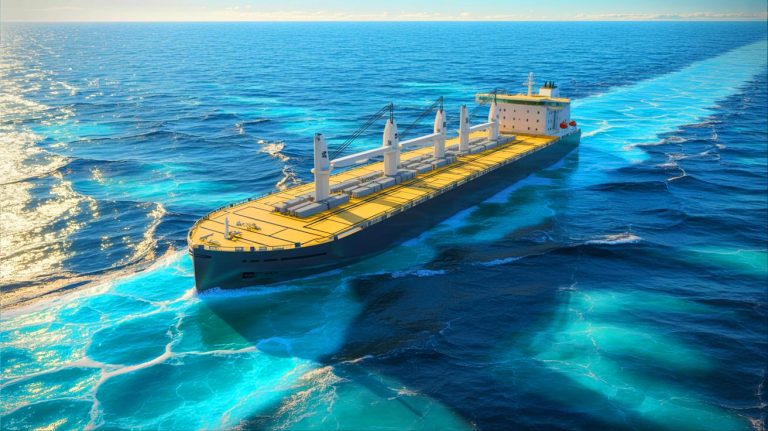| IN A NUTSHELL |
|
In a groundbreaking development for the maritime industry, Mitsui OSK Lines (MOL) and Mitsubishi Shipbuilding have unveiled a revolutionary vessel concept that sets a new standard for sustainability and efficiency. This innovative carrier is capable of transporting both liquefied carbon dioxide (LCO2) and methanol, marking a significant leap forward in the quest for a greener maritime economy. The design recently received the world’s first Approval in Principle (AiP) from classification society ClassNK, highlighting its potential to reshape the shipping landscape. As the world grapples with climate change, this dual-purpose ship offers a promising solution to reduce emissions and promote a circular carbon economy.
The Dual-Purpose Carrier: A Game Changer in Maritime Transport
The introduction of this dual-purpose carrier represents a pivotal moment in the maritime sector. Designed with a keen focus on efficiency and sustainability, the vessel is a testament to innovative engineering. By carrying LCO2 on outbound routes and synthetic methanol on the return journey, it eliminates the inefficiency of empty ballast trips, thereby maximizing operational efficiency. This approach not only reduces emissions but also supports a more circular maritime economy by integrating carbon capture and recycling processes into its operations.
As the shipping industry faces increasing pressure to reduce its carbon footprint, the dual-purpose carrier offers a pragmatic and forward-thinking solution. It effectively addresses the need for cleaner ocean transport while fostering the development of a low-emission maritime economy. By integrating carbon capture, utilization, and storage (CCUS) technologies, the vessel embodies a holistic approach to sustainability that could inspire future innovations in the industry.
Synthetic Methanol: The Fuel of the Future
Synthetic methanol, produced from captured CO2, is gaining traction as a clean marine fuel. This development is particularly timely as the world seeks alternatives to traditional fossil fuels. The dual-purpose carrier’s ability to transport synthetic methanol underscores its role in advancing sustainable fuel solutions within the maritime sector. The use of synthetic methanol not only reduces emissions but also recycles carbon, making it a compelling option for the shipping industry.
The growing interest in synthetic methanol highlights its potential as a key player in the transition to cleaner energy sources. By enabling the transportation of this promising fuel, the dual-purpose carrier facilitates the widespread adoption of low-carbon technologies that are essential for achieving global climate goals. As shipping companies strive to align with international emissions targets, the integration of synthetic methanol into maritime operations could serve as a catalyst for broader environmental change.
Technical Innovations: The Backbone of the Dual-Purpose Carrier
The dual-purpose carrier is built on a low-pressure LCO2 carrier framework and has been modified to meet the technical demands of transporting both liquefied CO2 and methanol. This technical innovation ensures that the vessel remains a flexible and forward-looking asset in the move toward cleaner ocean transport. The modifications made to accommodate both cargo types highlight the vessel’s adaptability and potential to serve a variety of maritime needs.
These technical enhancements demonstrate the shipbuilders’ commitment to pioneering environmentally-friendly solutions that balance performance with sustainability. By addressing the complexities of transporting dual cargoes, the vessel sets a new benchmark for versatility in the shipping industry. As a result, it offers shipping companies a unique opportunity to optimize their operations while contributing to global efforts to mitigate climate change.
The Road Ahead: Implications for the Shipping Industry
The introduction of this dual-purpose carrier has far-reaching implications for the shipping industry. It not only sets a precedent for future vessel designs but also signals a shift toward more sustainable maritime practices. The vessel’s dual benefit of reducing emissions and recycling carbon positions it as a viable solution to some of the industry’s most pressing environmental challenges.
As the world continues to prioritize sustainability, the shipping industry must adapt to evolving demands for cleaner transport solutions. The dual-purpose carrier serves as a model for how innovation can drive positive change in traditional sectors. This groundbreaking vessel raises important questions about the future of maritime transport: How can the industry further integrate sustainable technologies to accelerate the transition to a low-emission economy?
Did you like it? 4.5/5 (23)






Wow, this ship sounds like something out of a sci-fi movie! 🚀
How long did it take to develop this dual-purpose carrier?
This is great news for the environment. Thanks for sharing! 🌍
Is the use of synthetic methanol economically viable right now?
Could this technology be adapted for smaller vessels?
Are there any other ships like this being developed elsewhere in the world?
How much CO2 can this ship actually carry?
Isn’t it risky to transport both LCO2 and methanol on the same ship?
I wonder if this will lead to lower shipping costs in the long run.